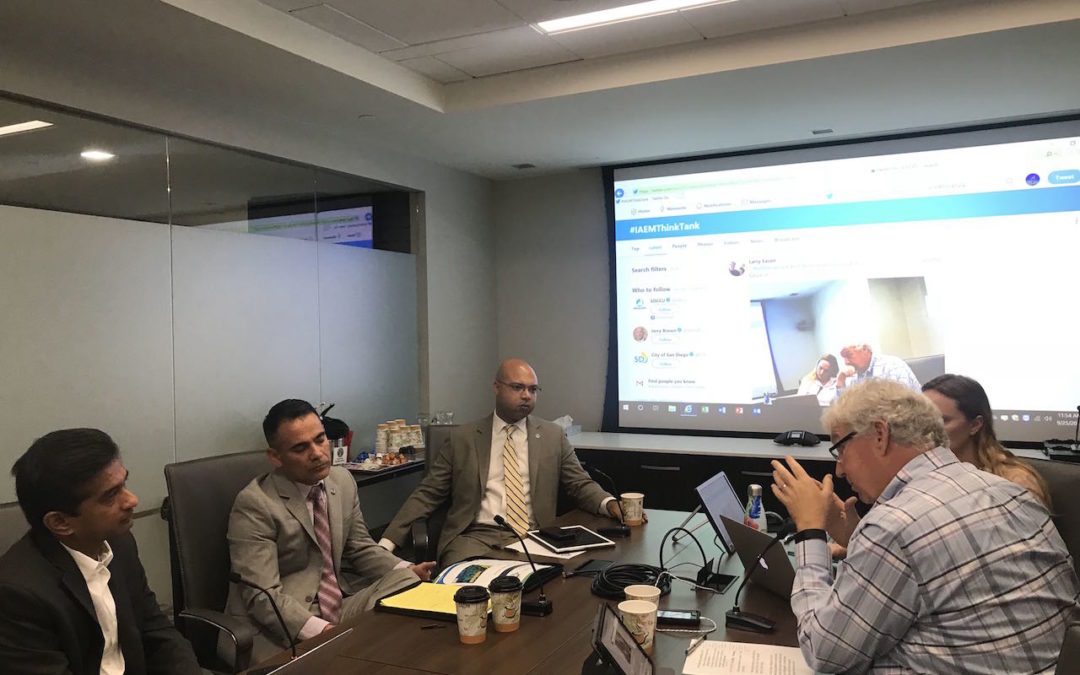BY LARRY EASON
There is no question that Smart Cities will bring an exponential increase in data to city leaders and the public. But how well cities translate a potentially overwhelming volume of data into useful information and lifesaving action will depend on smart leadership and effective public/private partnerships.
To really benefit from smart tech we’ve got to get this right. So I was thrilled to learn that Smart Cities and emergency response would be the theme of a recent International Association of Emergency Managers (IAEM) Think Tank discussion. Titled “Smart Cities – How New Technology, Including Nanotechnology, Can Enhance All Phases of Emergency Management”, the discussion was sponsored by IAEM and hosted in our home city of San Diego.
If you are not an emergency response professional there’s a good chance you haven’t hear of these IAEM Think Tanks. They are in-person and on-line forums bringing together emergency management professionals from around the world to promote innovation and collaboration. These discussions are essential so we can work together to deploy Smart Cities solutions that have a positive impact on society and the world.
These Think Tanks were conceived by Former FEMA Deputy Administrator Rich Serino, currently a Distinguished Visiting Fellow at Harvard University’s National Preparedness Leadership Initiative, Senior Advisor at MIT’s Urban Risk Lab and AerNos Advisor. Rich is recognized as an innovator and an advocate for using new technologies, such as IoT/Smart City technologies, to improve emergency response and public health.
It was terrific that Rich selected San Diego as the location for this discussion and an honor that our CEO Sundip Doshi was invited to participate along with San Diego City officials Erik Campbell, Director of Economic Development Department and John Valencia, Executive Director Office of Homeland Security. Erik and John shared their on-the-ground perspective on these early days of IoT powered Smart Cities.
I was excited to hear Erik say that the heart of a Smart City will be leveraging data to provide more and better services and reduced costs. And that he envisions emergency management as one area where data could not only provide better services but also save the lives of citizens and first responders. I agree with his viewpoint that he’d like to see cities as focused as companies like Amazon on anticipating and meeting the needs of citizens.
San Diego has embraced Smart Cities with the largest IOT urban deployment of intelligent street lights – 4200 in the network – with video, audio and atmospheric sensors. Through these sensors, the city can gather data to analyze traffic control, air quality, and barometric pressure, with potential applications that include rerouting traffic during emergencies to avoid danger zones.
Sundip shared how at AerNos we are working with partners to deploy future networks of gas sensors that will be embedded in smart street lights and parking meters and worn by first responders and citizens. These dense sensor networks will give officials and the public unprecedented information, in real time, about day-to-day pollution levels and dangerous gas leaks when disasters and emergencies strike.
John reinforced how important a public/private collaboration is and everyone agreed that cities cannot do this alone. Success will require effective government, private sector and academic partnerships to get the most out of Smart City technology. By working together, we have the best shot at identifying and deploying the technologies available today and doing it in a way that will bring immediate benefits for citizens, while laying a foundation for even greater progress in the future.
During the Think Tank, I was encouraged by the interest and thoughtful questions from the emergency management professionals around the world. Clearly, we are at the beginning of something profound. Smart City technologies will shape the future of our communities and lives and conversations like this IAEM Think Tank increase the chance that we will get it right.
To hear the Audio on YouTube, Click Here.

